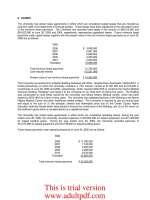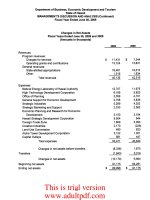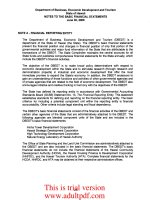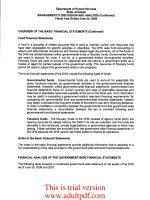NISHIHAMA & KISHIDA, CPAs, INC. CERTIFIED PUBLIC ACCOUNTANTS FINANCIAL AUDIT OF THE DEPARTMENT OF EDUCATION STATE OF HAWAII Fiscal Year Ended June 30, 2005_part2 potx
Bạn đang xem bản rút gọn của tài liệu. Xem và tải ngay bản đầy đủ của tài liệu tại đây (350.57 KB, 10 trang )
State
of
Hawaii
Department
of
Education
MANAGEMENT'S DISCUSSION AND ANALYSIS (Continued)
Fiscal Year Ended
June
30, 2005
GOVERNMENT-WIDE FINANCIAL ANALYSIS
The following discussion highlights management's understanding of the key aspects of the
Department's financial activities.
Net Assets. The Department's largest portion of net assets
is
capital assets
(e.g.
land, buildings,
equipment), which are unavailable for future spending. The Department's unrestricted net assets
are available for future use to provide program services. However,
in
FY2004-05, liabilities
exceeded unrestricted assets
(cash
and
receivables).
Exhibit
A-2
Government-Wide
Condensed Statement
of
Net Assets
Fiscal Years 2005 and 2004
(Amounts in millions)
Governmental Activities
2005
2004
Assets
Current
$ 170.0
$ 156.8
Non-current (Capital assets, net depreciation)
807.9
810.0
TOTAL ASSETS
$
977.9
$ 966.8
Liabilities
Current
$ 138.7
$ 122.4
Non-current
70.9
57.0
Total Liabilities
209.6
179.4
Net Assets
Restricted (Capital assets, net depreciation) 807.9
810.0
Unrestricted
(39.6)
(22.6)
Total Net Assets
768.3
787.4
TOTAL LIABILITIES AND NET ASSETS
$
977.9
$
966.8
Changes in Net Assets. Total net assets decreased
by
$19 million (see Exhibit A-3). However,
the Department did not outspend available funds. The State's budget guidelines do not allow
cash
expenditures
in
excess of available funds. The decrease
is
primarily due
to
current year
depreciation expense
and
increases
in
net compensated absence credits
and
workers'
compensation liability. Refer to Note C for details of capital assets
and
depreciation
by
category.
11
This is trial version
www.adultpdf.com
State
of
Hawaii
Department
of
Education
MANAGEMENT'S DISCUSSION AND ANALYSIS (Continued)
Fiscal Year Ended June 30, 2005
Depreciation expense does not require the use of cash; it is
an
accounting term representing the
decrease
in
assets' value over a period
of
time. This includes wear, tear, age, deterioration, and
obsolescence. Although depreciation is a commonly known term
in
commercial industry, GASB 34
requires all governmental agencies to record depreciation of its capital assets.
ExhibitA-3
Government-Wide
Changes in Net Assets
Fiscal Years 2005 and 2004
(Amounts
in
millions)
Governmental Activities
2005
2004
Revenues
State appropriations
$ 1,544.2
$
1,430.0
Federal funds 235.3 224.5
Other revenues
56.7 45.7
Total Revenues
1,836.2 1,700.2
Expenses
School level instruction
1,063.3
1,045.5
Comprehensive student support 406.7 398.5
Instructional support 44.5 47.3
State and district administration
40.1
36.7
School support
228.1
196.3
School community service
19.3 17.6
Public libraries 31.3 29.7
Capital outlay
14.7 .7
Other
7.3 5.7
Total Expenses
1,855.3 1,778.0
Transfers
.3
Change
in
Net Assets
(19.1) (77.5)
Beginning Net Assets 787.4 864.9
Ending Net Assets
$
768.3
$
787.4
12
This is trial version
www.adultpdf.com
State
of
Hawaii
Department
of
Education
MANAGEMENT'S DISCUSSION AND ANALYSIS (Continued)
Fiscal Year Ended
June
30, 2005
EXPLANATION OF MAJOR DEPARTMENTAL PROGRAMS
The State Budget
is
organized by major program areas. The Department's major programs are:
Program
#
EDN 100
EDN 150
EDN 200
EDN 300
EDN 400
EDN 407
EDN 500
Program Title
School-Based Budgeting
Comprehensive Student
Support Services
Instructional Support
State and District
Administration
School Support
Hawaii State Public Library
System
School Community Services
Program Description
Instructional services, curriculum programs, at-risk
programs, fringe benefits, and debt service.
Special needs assessment, special education services,
school-based behavioral health services, and other
related services required for a free and appropriate
public education, autism services, and professional
development.
Curriculum support, assessment, planning, information
technology support, and school leadership training.
Board of Education, Superintendent, Complex Area
Superintendents, budget, communications, civil rights
compliance, internal audit, business services, human
resources, and information technology.
School food services, utilities, custodial services, repair
and maintenance, and student transportation.
The Hawaii State Public Library System
is
included
in
the Department's combined financial statements since
both the Library System and the Department are
administratively and legally supervised by the Hawaii
State Board of Education.
After school care and adult education.
13
This is trial version
www.adultpdf.com
State of Hawaii
Department
of
Education
MANAGEMENT'S DISCUSSION AND ANALYSIS (Continued)
Fiscal Year Ended June 30, 2005
Exhibit A-4 summarizes the Department's revenue. Revenues are primarily from state general
funds (taxpayer monies). Other revenues are from federal grants, special funds to support specific
programs such as cafeteria collections for school food services, and donations.
Exhibit A-4
FY2005
Revenue:
Where
the
Money
Came
From
Federal
Funds
13%
Other
Revenues
2%
Capital
Projects
1%
General
Funds
84%
Exhibit A-5 summarizes the Department's expenses. A total
of
94% of Department expenditures
are for school-level instructional and support programs
in
EDN 100, 150, 400, and 500, while only
2% are for State and District Administration.
Exhibit A-5
FY2005
Expenses:
Where
the
Money
Was
Spent
Instructional
Support,
2%
State
and
District
Administration,
2%
14
Hawaii
State
Library
System,
2%
School-Level
I
nstruction
and
Operational
Support,
94%
This is trial version
www.adultpdf.com
State
of
Hawaii
Department
of
Education
MANAGEMENT'S DISCUSSION AND ANALYSIS (Continued)
Fiscal Year Ended June 30, 2005
GENERAL FUND BUDGETARY HIGHLIGHTS
The Department was appropriated general funds
of
$1,547.0 million
in
FY2004-05. General fund
allotments increased due to School Based Budgeting ($43.0 million), Comprehensive School
Support
($8.1
million), and
SLH
2005 legislative acts
6,
51,
and
87
($32.0 million), which were
offset by decreases to State and District Administration ($1.6 million) and reduced General Fund
carryover ($9.3 million).
The law permits the Department to "carryover"
up
to
5%
of
general fund appropriations from one
fiscal year to the next. The Department carried over $12.7 million in FY2003-04 general fund
appropriations for expenditures
in
FY2004-05. Carryover funds enable schools to make long-range
fiscal plans, save for major purchases for which single year funding may not
be
sufficient, and
provide funds to start the next school year, which occurs within weeks of the beginning
of
the fiscal
year.
FIDUCIARY FUNDS
Fiduciary funds or "local school funds" are held for students
in
a custodial capacity and do not
require deposit into the State Treasury. The fund contains monies collected and maintained by
schools for students. Examples include yearbook, newspaper fund, student government dues,
physical education uniform sales, and excursions. The funds are used for school activities that take
place outside formal class periods and are not required for class work or credit.
Fiduciary fund net assets were $17.4 million
in
FY2004-05, resulting
in
$3.0 million (21%) increase
from the prior fiscal year.
CAPITAL ASSET AND DEBT ADMINISTRATION
The Department's capital improvement program strives to provide facilities that are well placed,
sufficient
in
number, flexible, functional, and creatively designed to accommodate population
changes, support educational programs, and promote health and safety
of
students, employees,
and the public. The Departments of Accounting and General Services, Land and Natural
Resources, and Budget and Finance assist the department with various aspects
of
capital
improvement.
Buildings, building improvements, and land improvements less than $100,000 are not reported as
capital assets. This fiscal year's capital improvements included the construction of 17 classrooms.
Other projects are under construction,
in
the
bid
process, or are being designed. Four new
schools - Mililani Ike Elementary, Nanaikapono Elementary, Ocean Pointe Elementary, and Maui
Lani Elementary were under construction and 28 classroom projects were being designed. Please
refer to Note E for capital asset details.
15
This is trial version
www.adultpdf.com
State
of
Hawaii
Department
of
Education
MANAGEMENT'S DISCUSSION AND ANALYSIS (Continued)
Fiscal Year Ended
June
30, 2005
The Department's long-term debt
is
managed by the Department of Budget and Finance; however,
general fund appropriations for interest payment
and
debt retirement are included
in
the
Department's budget. Interest payments and debt retired were $98.3 million
in
FY2004-05,
resulting
in
less than a 1% decrease from the prior fiscal year.
ECONOMIC FACTORS AND NEXT YEAR'S BUDGET
The State's unemployment rate has been at a record low with seasonally adjusted
unemployment rate being as low as 2.7%
in
October. One year ago, Hawaii's seasonally
adjusted unemployment rate was
3.1
% while the national rate was 5.5%.
Cumulative tax collections for the first five months of FY2005-06 exceeded $2.0 billion or $244.4
million more than the corresponding period last year. General excise and use tax collections,
which are the largest source of revenue and a good measure of economic growth, increased
13.0%
in
the same period.
In
September 2005, the Council on Revenues estimated that the General Fund tax growth rate
would be 6.0%
in
FY2005-06 and 6.6%
in
FY2006-07. Actual General Fund tax collections rose
by 13.7% in the first five months
of
FY2005-06 from FY 2004-05. Higher general excise and use
tax collections and the substantial rise
in
corporate income tax collections were the primary
factors underlying this strong performance.
In
November, the Council on Revenues revised its
forecast of Hawaii's growth
in
2006 total personal income from 7.3% to 8.2%.
FUTURE EVENTS THAT
WILL
FINANCIALLY IMPACT THE DEPARTMENT
Act 51, the Reinventing Education Act
of
2004, has enabled the Department to significantly
reshape Hawaii's public school system. The Act identifies a number of critical goals, with some
financially impacting the Department.
The Act strives to address student individual needs by requiring the establishment
of
a weighted
student formula to allocate funds to public schools. It also requires that school principals expend
not less than seventy per cent (70%) of operating funds for the Department, excluding debt
service and capital improvement programs. These efforts will be directed towards strengthening
the relationship
of
financial resources to the academic plans
of
each school, with the overall
goal
of
improving student achievement. The proposed weighted student formula timeline has
included:
• Development
of
weights
in
school year 2004-05, with refinements
in
2005-06;
• A pilot program during school years 2004-05 and 2005-06;
• Intensive training
in
school years 2004-05 and 2005-06; and
• Full implementation by school year 2006-07.
• Single school calendar implementation by school year 2006-07, resulting
in
$24 million
cost for two paychecks provided to 10-month employees affected by the calendar
change.
16
This is trial version
www.adultpdf.com
State
of
Hawaii
Department
of
Education
MANAGEMENT'S DISCUSSION AND ANALYSIS (Continued)
Fiscal Year Ended
June
30, 2005
The Act also strives to remove bureaucratic constraints that hamper the effectiveness of the
Department. To do this, the Act requires that certain State functions, accounts, and personnel
be
transferred to the Department. The State Educational Facilities Repair and Maintenance
Account and the School Physical Plant Operations and Maintenance Account (excluding
positions funded by these accounts) were transferred from the Department of Accounting and
General Services effective July
1,
2004.
Effective July
1,
2005, the Department of Accounting and General Services transferred capital
improvement projects, contract administration functions, repair and maintenance functions, and
positions to the Department. The State Department of Human Resources Development also
transferred centralized human resources system, recruitment, certification, examination,
management, classification, and compensation of the Department's employees, including labor
relations functions to the Department.
Future transfers to the Department from other State departments will include:
• The State Department of Human Services - employment background checks for the After-
School Plus Program, private vendors, and other employees
• The StateDepartment
of
Heath - transfer school health aides and public health nurses who
supervise the school nurse aids
In
addition
to
Act
51,
the Federal
No
Child
Left Behind Act
is
an
under funded federal mandate.
The Department estimates that
as
much
as
$30
million
in
additional resources
is
needed
for
compliance
in
Fiscal Year 2006,
and
the amount
will
grow larger
in
Fiscal Year 2006 if Title I
schools currently
in
need
of improvement or corrective action do not make Adequate Yearly
Progress (AYP) by 2006. Title I schools are those with the highest concentrations of poverty which
are receiving federal fund support
to
help disadvantaged students meet the same
high
standards
expected of
all
students. However, the performance goals specified
by
the Act
call
for the
Department to implement the requirements for
all
students, not only Title
I.
The Act does not
provide any funding to implement the requirements for non-Title I schools. Additional resources are
needed
to:
recruit, train,
and
pay highly qualified professionals
and
paraprofessionals; provide
extended school programs; provide student support services such
as
English for Second
Language Learners (ESLL), special education, and high school reform; provide safe school
environments;
and
implement the infrastructure required for testing, accountability analyses,
and
data collection.
CONTACTING THE DEPARTMENT'S FINANCIAL MANAGEMENT
The financial report
is
designed to provide the public with a general overview of the Department's
finances
and
demonstrate the Department's accountability for the money it receives. If
you
have
questions about this report or
need
additional financial information, please contact the Office of the
Superintendent, Department of Education,
P.O.
Box 2360, Honolulu, Hawaii 96804.
17
This is trial version
www.adultpdf.com
Department
of
Education
State
of
Hawaii
STATEMENT OF NET ASSETS
June 30, 2005
ASSETS
Cash
Certificates
of
deposit
Receivables
Due from federal government
Accounts receivable
Due from other agency
Total current assets
Property and equipment, net
of
accumulated depreciation
Total assets
LIABILITIES
Current liabilities
Vouchers and contracts payable
Accrued wages and employee benefits
Accrued compensated absences
Current portion
of
workers' compensation claims
Deferred revenues
Due to State
of
Hawaii General Fund
Due to others
Total current liabilities
Accrued compensated absences, less current portion
Workers' compensation claims
Total liabilities
NET ASSETS
Investment
in
capital assets
Unrestricted
Total net assets
See accompanying notes to the basic financial statements.
18
Governmental
Activities
$ 159,107,726
10,764
10,178,134
633,872
65,628
169,996,124
807,922,867
$
977,918,991
$ 27,175,574
84,449,810
6,542,009
12,849,800
1,779,186
5,109,076
878,447
138,783,902
38,464,039
32,413,268
209,661,209
807,922,867
(39,665,085)
$ 768,257,782
This is trial version
www.adultpdf.com
Department
of
Education
State
of
Hawaii
STATEMENT OF ACTIVITIES
Fiscal Year Ended
June
30, 2005
Net Expense
and Changes
Program Revenues
in Net Assets
Operating
Charges
for
Grants and
Governmental
Functions/Programs Expenses Services
Contributions Activities
Governmental activities:
School level instruction
$
1,063,377,689
$
8,759,381
$
137,006,101
$
(917,612,207)
Comprehensive student support 406,705,714
37,861,026
(368,844,688)
Instructional support 44,480,426 4,191,897
11,519,113
(28,769,416)
State and district administration 40,098,443
791,648 25,414
(39,281,381 )
School support 228,152,943 19,077,501
43,669,402 (165,406,040)
School community service 19,266,827 2,292,491
3,999,859 (12,974,477)
Public libraries
31,303,460
2,191,430
1,205,650 (27,906,380)
co
Capital outlay 14,670,408
10,819,000 (3,851,408)
Other
7,275,256
7,850,044 574,788
Total governmental activities
$
1,855,331,166
$
37,304,348
$
253,955,609
(1,564,071,209)
General revenues:
State allotted appropriations, net
of
lapses
1,544,199,965
Unrestricted investment earnings
772,538
Total general revenues
1,544,972,503
Change in net assets
(19,098,706)
Net assets at
July
1, 2004
787,356,488
Net assets
at
June
30, 2005
$
768,257,782
See
accompanying
notes
to
the
basic financial statements.
This is trial version
www.adultpdf.com
Department of Education
State of Hawaii
BALANCE
SHEET·
GOVERNMENTAL
FUNDS
June 30, 2005
Capital
General
Federal Projects
Other
Total
ASSETS
Cash
$
87,028,484
$
35,217,525
$
3,401,506
$
33,460,211
$
159,107,726
Certificates
of
deposit
10,764
10,764
Receivables
Due
from
federal
government
10,178,134
10,178,134
Accounts
receivable
633,872
633,872
Due
from
other
agency
65,628
65,628
Total
assets
$
87,028,484
$
45,395,659
$
3,401,506
$
34,170,475
$
169,996,124
LIABILITIES AND FUND BALANCES
LIABILITIES
Vouchers
and
contracts
payable
$
15,433,664
$
4,490,702
$
5,111,598
$
2,139,610
$
27,175,574
Accrued
wages
and
employee
benefits
payable
78,439,778
4,285,691
21,904
1,702,437
84,449,810
Deferred
revenues
1,779,186
1,779,186
Due
to
State
of
Hawaii
General
Fund
5,109,076
5,109,076
Due
to
others
878,447
878,447
Total
liabilities
98,982,518
11,434,026
5,133,502
3,842,047 119,392,093
FUND BALANCES
Reserved
for
encumbrances
37,101,100
10,900,742
36,129,485
2,535,176
86,666,503
Reserved
for
continuing
appropriations
30,780,541
30,780,541
Unreserved
(79,835,675)
23,060,891
(37,861,481)
27,793,252
(66,843,013)
Total
fund
balances
(deficit)
(11,954,034)
33,961,633
(1,731,996)
30,328,428
50,604,031
Total
liabilities
and
fund
balances
$
87,028,484
$
45,395,659
$
3,401,506
$
34,170,475
$
169,996,124
See accompanying notes to the basic financial statements.
20
This is trial version
www.adultpdf.com









